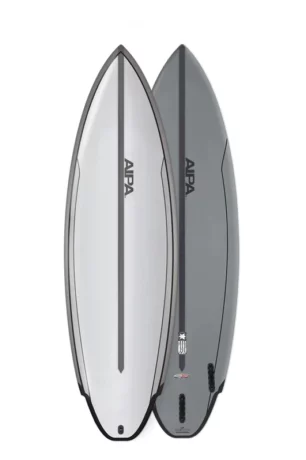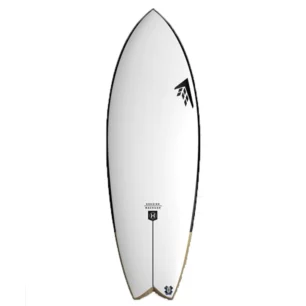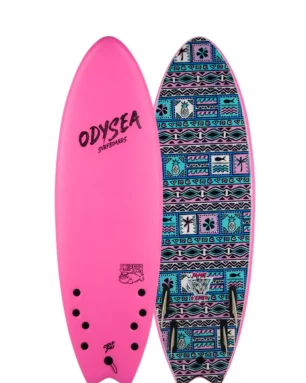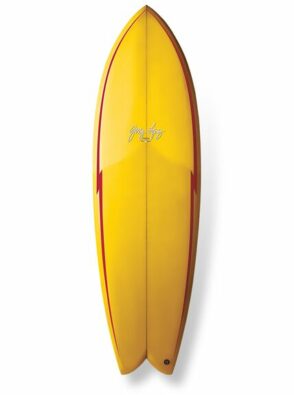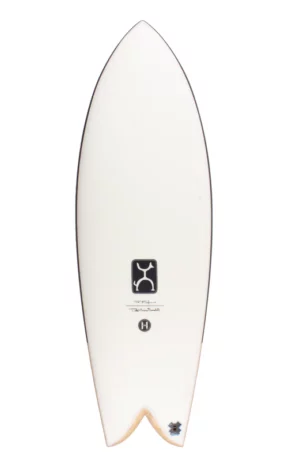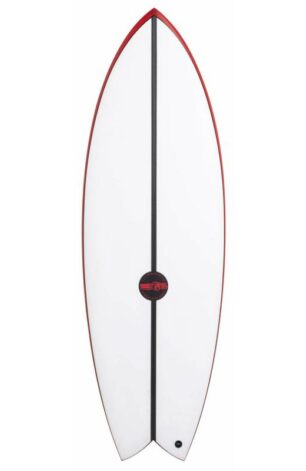Fish Surfboards: The Definitive Guide for 2024
Daniel Lofaso
The fish surfboard has made a major resurgence in surf lineups around the globe. They are fast, versatile, and most of all, fun.
Unlike your traditional shortboard, the purchase of a fish takes a bit more of your surfing into consideration. For example, you can get a modern fish that allows you to do more pocket surfing or a more traditional shape for down the line surfing.
Fish surfboards of today can be your daily driver, allowing you to perform on average mushy days and rip on fun, offshore days alike. Many shapers are going after the do-everything surfer with their fish, allowing their shapes to perform like a shortboard with the speed and flow benefits of a fish.
Below, you’ll find some options for each type of surfing, as well as some history and details about the fish that will let you know why this a must-have in your quiver.
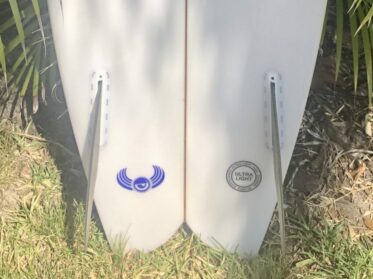
Our pick for
Best all around fish surfboard
Surftech x AIPA Dark Twinn Surfboard
Introducing the Dark Twinn, a remarkable twin surfboard model derived from the renowned Dark Series lineup. Developed alongside its quad counterpart, the Dark Horse, this high-performance groveler shares a common outline and core components. However, it distinguishes itself by strategically placing the wings to optimize the wing-to-fin relationship, enhancing the board's performance in this specific fin configuration.
With its mid-range rockers, lowered rail apex line, and carefully crafted bottom contour featuring a progressive roll from the nose to a single concave under the front foot, transitioning to a deep double concave between the front fins, and finally blending into a satisfying amount of vee/double through the wing and tail, the Dark Twinn is a lively and responsive board.
In the Surftech construction, this board is virtually indestructible and will provide you with fun sessions for years to come.
Our pick for
Best eco-friendly surfboard
Seaside by Firewire
I’ve spoken to people who absolutely loved this board and others who passionately hated it. When you see Rob Machado surf it you probably get mesmerized by his style and flow, which is what this board was built to do. Like the FishBeard from Channel Islands, this fish is meant to give you the traditional cruisy and fun feel most enjoy from a fish, but with a pulled in tail and narrower nose than a traditional fish which allows for tighter turns.
Note that this board can only be ridden as a quad, so if you are looking to reuse some existing fins, you may have to invest in some fins too.
Our pick for
Best low cost fish surfboard
Skipper Quad x Jamie O'brien Pro
This softtop fish from Catch Surf is the perfect summertime board for kids or someone who really doesn’t want to take their surfing too serious. That said, it doesn’t mean you can’t do some serious surfing on this board, I’ve seen some guys out on these on fun days catching tons of waves whilst performing on them, so this is certainly a high-performance softtop, as far as softtops go.
Our pick for
Best old school fish surfboard
Something Fishy by Gerry Lopez
The most traditional of all the fish shapes on this list, the Something Fishy by Gerry Lopez will give you a smile out in the water as much as it would as a piece of wall art.
This shape dates back to the 70’s, so expect a very fun, fast, down-the-line fish that floats over sections, provides a fairly user-friendly feel, but is limited in terms of vertical surfing.
Our pick for
Best modern fish surfboard
Firewire Too Fish Surfboard by Rob Machado
Rob says that the Too Fish is " My favorite in small and weak waves because of how thick and floaty it is in the forward two thirds of the board, but this shape is also thinned out aggressively in the tail to enable hold in powerful waves. I've ridden the Too Fish in everything from overhead waves on the North Shore to perfect days on the reef at home, and also the weakest most disorganized junk surf at the beach break in front of my house. This is my favorite board for all conditions."
Our pick for
Best surf-anything fish surfboard
Round Nose Fish by …Lost Soft Top
No fish list is complete without mentioning the …Lost Round Nose Fish (RNF). This version is the soft top, something to leave in the car and take a little less seriously.
The RNF is best described by shaper Matt Biolos in his write up on his site:
I’ve always felt the key difference between our RNF and the majority of others, from the 90’s and beyond, is the fact that our outline was always more based off of MR inspired, high performance, competitive minded, twin fins of the late 70’s/early 80’s. Relatively pulled in tails, developed through trial and error, for maximum performance and control…not just in small surf, but in all size and shape of waves.
Our pick for
Best high-performance fish surfboard
Fishbeard by Channel Islands
This board is meant to be a hybrid between a Neck Beard 2 – a wide-nosed user-friendly board – and a keel-fin fish – something that absolutely hauls ass down the line but can get funky wit it. It’s also a bit of a hybrid in the sense that it does a lot of things a typical shortboard will do but it has the desired down-the-line speed capabilities you look for in a fish.
Check out our original review of the Fishbeard.
Our pick for
Best small wave fish surfboard
Red Baron by JS
Not to be outdone by other larger brands capitalizing on the resurgence of the fish movement, JS Industries has created this fun little Red Baron fish. You may have seen it’s older brother, the Black Baron, the more high performance version of their fish. This option is the more entry-level of the two, with a little extra width in the tail and a board more suited for speed generation while maintaining some modicum of vertical surfing. If you are a fan of JS boards and want a fish, either the Red of Black Baron options will certainly suit your fancy and can be seen at beaches everywhere.
What is a Fish Surfboard?
A fish surfboard is a type of surfboard designed with a specific shape and characteristics that are intended to enhance a surfer's performance in certain wave conditions. It's named after its resemblance to the shape of a fish, with a wide and flat nose that tapers into a narrower tail. This distinctive shape provides the fish surfboard with a unique set of features that make it well-suited for particular types of waves.
These boards originated in the 1960s as a response to the limitations of traditional longboards and the high-performance shortboards of that era. Surfers sought a board that combined the best of both worlds: the wave-catching ability of a longboard and the maneuverability of a shortboard. The fish design emerged as a solution, and it has remained popular ever since.
Types of Fish Surfboards
Fish Tail Surfboard (Retro or classic fish)
The classic fish surfboard embodies the original design principles of the fish shape that emerged in the 1960s. Its key characteristics include:
- Wide and Flat: A wide, flat, and relatively short board with a distinct swallowtail (split tail) design.
- Twin Fins: Equipped with a twin fin setup positioned close to the rails. This enhances maneuverability and provides a loose feel on the wave.
- Low Rocker: Features a relatively flat bottom curve (rocker) that promotes speed and early wave entry.
- Buoyancy: Due to its width and thickness, it offers excellent floatation and wave-catching ability.
- Ideal Conditions: Performs well in smaller, mushy waves where speed and quick turns are essential.
Perfomance Fish Surfboard
The performance fish takes the classic fish design and incorporates modern advancements to suit the needs of more experienced surfers. Its characteristics include:
- Refined Shape: Retains the wider outline and swallowtail of the classic fish, but often with slightly more refined curves and dimensions.
- Quad Fin Option: While twin fins are still common, performance fish boards may have the option for a quad fin setup (four fins) to provide enhanced drive and control.
- Enhanced Maneuverability: Designed for sharper and more controlled turns while maintaining the fish's signature speed and flow.
- Moderate Rocker: Balances speed with maneuverability, often featuring a rocker that's slightly more pronounced than the classic fish.
- Versatility: Can handle a wider range of wave conditions, from smaller waves to slightly larger and more powerful waves.
Hybrid Fish Surfboard
The hybrid fish takes inspiration from both traditional fish and high-performance shortboards, blending elements for a versatile surfing experience. Its features include:
- Modified Outline: A more refined shape that combines the width of a classic fish with a narrower nose and tail for improved performance.
- Fusion Fin Setup: Can feature a variety of fin setups, such as a traditional twin fin, a quad fin, or a combination of both (known as a "5-fin setup"), offering adaptability to different wave types.
- Balanced Rocker: Strikes a balance between speed generation and responsiveness, making it suitable for a wider range of wave conditions.
- All-Around Performance: Offers the wave-catching ability of a fish combined with the maneuverability and performance aspects of a shortboard.
- Intermediate to Advanced Surfers: Best suited for surfers with some experience who want a versatile board for varying conditions.
Fish Surfboard Shapes
Key characteristics of a fish surfboard include:
Wide Outline: The wider nose and midsection of the board give it extra stability and buoyancy, allowing the surfer to catch waves earlier and with ease.
Swallow Tail: The tail of a fish surfboard is often split into two distinct points, creating a shape known as a "swallow tail." This design feature allows for quick and responsive turns, making it ideal for maneuvering in smaller and mushier waves.
Low Rocker: Fish surfboards typically have a flatter curvature along the bottom (known as the rocker), which enables them to glide over flat sections of waves and generate speed more efficiently.
Twin Fins: Fish surfboards traditionally feature a twin fin setup, where two smaller fins are placed closer to the rails (sides) of the board. This configuration enhances maneuverability and allows for sharper turns.
Wider Overall: Compared to traditional shortboards, fish surfboards are often wider, shorter, and thicker. This provides better stability, wave-catching ability, and paddling power.
Best Fish Surfboard for Beginners
If you are looking for a beginner fish to surf on and enjoy the benefits of a little extra foam and the ability to progress your surfing, I have to give the recommendation to the Skipper Quad x JOB. It’s the best pick for beginners because of its price point – the Skipper is just north of $340 depending on the size – and because of its foam construction. For a fun, floatie board that won’t break the bank and comes with fins, this is an easy choice.
Fish Surfboard FAQ
What are fish surfboards good for?
Fish surfboards are especially well-suited for small to medium-sized waves, and they excel in conditions where speed and quick turns are essential.
What’s the difference between a fish vs a shortboard?
A fish surfboard is wider, shorter, and often has a swallowtail, optimized for smaller waves and a more relaxed style of surfing. A shortboard, on the other hand, is narrower and longer, designed for high-performance maneuvers and better suited to powerful waves and experienced surfers.
What’s the difference between a fish vs a funboard?
A fish surfboard is shorter, wider, and excels in smaller waves, prioritizing speed and maneuverability. A funboard, which is slightly longer and wider than a shortboard, strikes a balance between stability and maneuverability, suitable for a broader range of conditions and intermediate surfers.
Are fish surfboards good for beginners?
Fish surfboards are not typically recommended for absolute beginners. They are designed to excel in specific wave conditions and require a certain level of skill to fully enjoy. Beginners usually benefit from longer, more stable boards like longboards or foamboards, which offer better stability for learning to paddle, balance, and catch waves. Once a beginner has gained some experience and comfort in the water, they can consider transitioning to a fish surfboard if they are interested in that style of surfing.
What size fish surfboard should I get?
The size of a fish surfboard depends on factors such as your skill level, weight, height, and the types of waves you plan to ride. As a general guideline, you’d want to use a surfboard volume calculator to get a baseline for the volume of the surfboard you can ride. However, as fish boards are intended to be a bit more buoyant than the average shortboard, they are not as attached to the volume recommendations. In other words, you could easily get a really fun, cruisy fish that was three, four, or even five liters more than what your shortboard volume would be.
Best Fish Surfboard Analysis Criteria
As mentioned, the best fish surfboard for you may not be the best fish surfboard for someone else. Where you may want something cruisy for styling down the line, someone else may want something they can do some new school maneuvers on.
I’ve personally surfed most of the boards on this list or have friends who own one of these boards. I love board design, so naturally I talk to my friends (and strangers!) in the lineup about what they are riding and how they like their boards.
Surfboard shapers don’t publish sales data, and there is no central hub where surfers buy boards where you can find loads of reviews (like Amazon), so you just sort of have to know a thing or two about boards, brands, and shapers.
Most or all of the products featured in our reviews are from affiliate partners who compensate us if you make a purchase on their sites. While this may influence the products we review, we do provide candid evaluations and only recommend products we genuinely like. Here's more information on how we make money.

